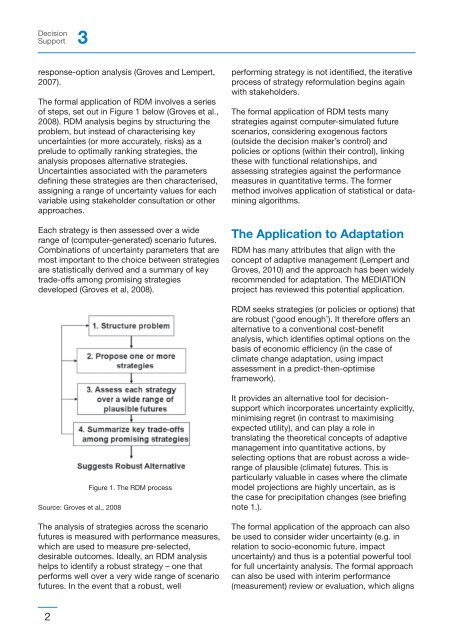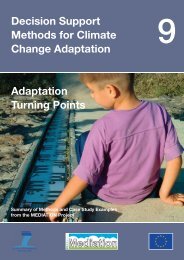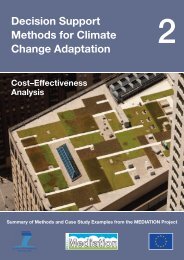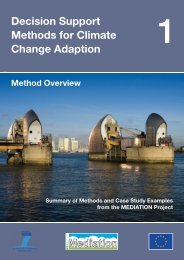Download all Technical Policy Briefing Notes in a single ... - Mediation
Download all Technical Policy Briefing Notes in a single ... - Mediation
Download all Technical Policy Briefing Notes in a single ... - Mediation
- No tags were found...
Create successful ePaper yourself
Turn your PDF publications into a flip-book with our unique Google optimized e-Paper software.
DecisionSupport 3response-option analysis (Groves and Lempert,2007).The formal application of RDM <strong>in</strong>volves a seriesof steps, set out <strong>in</strong> Figure 1 below (Groves et al.,2008). RDM analysis beg<strong>in</strong>s by structur<strong>in</strong>g theproblem, but <strong>in</strong>stead of characteris<strong>in</strong>g keyuncerta<strong>in</strong>ties (or more accurately, risks) as aprelude to optim<strong>all</strong>y rank<strong>in</strong>g strategies, theanalysis proposes alternative strategies.Uncerta<strong>in</strong>ties associated with the parametersdef<strong>in</strong><strong>in</strong>g these strategies are then characterised,assign<strong>in</strong>g a range of uncerta<strong>in</strong>ty values for eachvariable us<strong>in</strong>g stakeholder consultation or otherapproaches.Each strategy is then assessed over a widerange of (computer-generated) scenario futures.Comb<strong>in</strong>ations of uncerta<strong>in</strong>ty parameters that aremost important to the choice between strategiesare statistic<strong>all</strong>y derived and a summary of keytrade-offs among promis<strong>in</strong>g strategiesdeveloped (Groves et al, 2008).perform<strong>in</strong>g strategy is not identified, the iterativeprocess of strategy reformulation beg<strong>in</strong>s aga<strong>in</strong>with stakeholders.The formal application of RDM tests manystrategies aga<strong>in</strong>st computer-simulated futurescenarios, consider<strong>in</strong>g exogenous factors(outside the decision maker’s control) andpolicies or options (with<strong>in</strong> their control), l<strong>in</strong>k<strong>in</strong>gthese with functional relationships, andassess<strong>in</strong>g strategies aga<strong>in</strong>st the performancemeasures <strong>in</strong> quantitative terms. The formermethod <strong>in</strong>volves application of statistical or datam<strong>in</strong><strong>in</strong>galgorithms.The Application to AdaptationRDM has many attributes that align with theconcept of adaptive management (Lempert andGroves, 2010) and the approach has been widelyrecommended for adaptation. The MEDIATIONproject has reviewed this potential application.RDM seeks strategies (or policies or options) thatare robust (‘good enough’). It therefore offers analternative to a conventional cost-benefitanalysis, which identifies optimal options on thebasis of economic efficiency (<strong>in</strong> the case ofclimate change adaptation, us<strong>in</strong>g impactassessment <strong>in</strong> a predict-then-optimiseframework).Source: Groves et al., 2008Figure 1. The RDM processThe analysis of strategies across the scenariofutures is measured with performance measures,which are used to measure pre-selected,desirable outcomes. Ide<strong>all</strong>y, an RDM analysishelps to identify a robust strategy – one thatperforms well over a very wide range of scenariofutures. In the event that a robust, wellIt provides an alternative tool for decisionsupportwhich <strong>in</strong>corporates uncerta<strong>in</strong>ty explicitly,m<strong>in</strong>imis<strong>in</strong>g regret (<strong>in</strong> contrast to maximis<strong>in</strong>gexpected utility), and can play a role <strong>in</strong>translat<strong>in</strong>g the theoretical concepts of adaptivemanagement <strong>in</strong>to quantitative actions, byselect<strong>in</strong>g options that are robust across a widerangeof plausible (climate) futures. This isparticularly valuable <strong>in</strong> cases where the climatemodel projections are highly uncerta<strong>in</strong>, as isthe case for precipitation changes (see brief<strong>in</strong>gnote 1.).The formal application of the approach can alsobe used to consider wider uncerta<strong>in</strong>ty (e.g. <strong>in</strong>relation to socio-economic future, impactuncerta<strong>in</strong>ty) and thus is a potential powerful toolfor full uncerta<strong>in</strong>ty analysis. The formal approachcan also be used with <strong>in</strong>terim performance(measurement) review or evaluation, which aligns2





